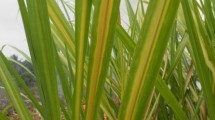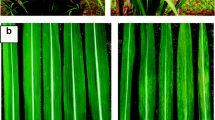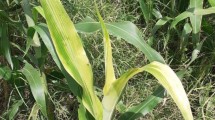Abstract
Vegetative propagation in sugarcane favours accumulation of pathogens inside the canes and carryover of pathogenic inoculum through planting materials. Except foliar diseases, disease-infected setts serve as a primary source for disease spread for most of the diseases in the crop. In case of fungal diseases, planting infected setts leads to disease builds up in plant crop and probably death of the affected clump. However, in case of non-fungal diseases continuous accumulation of pathogens systemically leads to loss of vigour in sugarcane varieties referred to as ‘varietal degeneration’ and this results in loss of yield potential in elite commercial varieties. Past decades witnessed many such instances of degeneration in popular sugarcane varieties and their replacement with new varieties. With the development of precise molecular diagnostic tools, the associated pathogens were precisely identified. Under Indian conditions, it was found that combined or separate infections of viruses causing mosaic and yellow leaf (YL), phytoplasmas causing grassy shoot and leaf yellows and bacterium causing ratoon stunting disease are associated with varietal degeneration. The degeneration was rapid and severe when all these pathogens infect sugarcane together as compared to their separate infections. However, among all these diseases, YL contributes more towards degeneration of sugarcane varieties. The disease occurrence to epidemic levels in different states is a serious concern for sugar industry and due to that longevity of the affected varieties in the field is threatened. Meristem-tip culture combined with molecular diagnosis was found effective eliminate the pathogens efficiently from the cane. Developing disease-free nurseries is imperative to sustain productivity of sugarcane and to realize yield potential of popular sugarcane varieties in India.
Similar content being viewed by others
References
Agnihotri, V.P. 1990. Diseases of sugarcane and sugar beet. New Delhi: Oxford & IBH Publishing Co Pvt Ltd.
Agnihotri, V.P. 1996. Current sugarcane scenario and management strategies. Indian Phytopathology 49: 109–126.
Bailey, R.A., and S.A. Tough. 1992. Ratoon stunting disease: survival of Clavibacter xyli subsp. xyli in field soil and its spread to newly planted sugarcane. Proceedings of South African Sugar Technologists Association Congress 66: 75–77.
Barber, C.A. 1921. The mosaic mottling disease of the sugarcane. International Sugar Journal 23: 12–19.
Chatenet, M., C. Delage, M. Ripolles, M. Irey, B.E.L. Lockhart, and P. Rott. 2001. Detection of Sugarcane yellow leaf virus in quarantine and production of virus-free sugarcane by apical meristem culture. Plant Disease 85: 1177–1180.
Cheong, E.L., R. Mock, and R. Li. 2012. Elimination of five viruses from sugarcane using in vitro culture of axillary buds and apical meristems. Plant Cell, Tissue and Organ Culture 109: 439–445.
Croft, B.J., A.D. Greet, T.M. Leaman, and D.S. Teakle. 1994. RSD diagnosis and varietal resistance screening in sugarcane using the EB-EIA technique. Proceedings of Australian Society of Sugar Cane Technologists 16: 143–151.
Fegan, M., B.J. Croft, D.S. Teakle, A.C. Hayward, and G.R. Smith. 1998. Sensitive and specific detection of Clavibacter xyli subsp. xyli, causal agent of ratoon stunting disease, with a polymerase chain reaction-based assay. Plant Pathology 47: 495–504.
Fontaniella, B., C. Vicente, E.M. Legaz, R. de Armas, C.W. Rodriguez, M. Martínez, D. Piñón, R. Acevedo, and M.T. Solas. 2003. Yellow leaf syndrome modifies the composition of sugarcane juices in polysaccharides, phenols and polyamines. Plant Physiology Biochemistry 41: 1027–1036.
Gonçalves, M.C., J. Vega, J.G. Oliveira, and M.M.A. Gomes. 2005. Sugarcane yellow leaf virus infection leads to alterations in photosynthetic efficiency and carbohydrate accumulation in sugarcane leaves. Fitopatologia Brasileira 30: 10–16.
Grisham, M.P. 2004. Ratoon stunting disease. In Sugarcane pathology, volume III: Bacterial and nematode diseases, ed. G.P. Rao, A.S. Saumtally, and P. Rott, 77–96. Enfield: Science Publishers Inc.
Grisham, M.P., G. Eggleston, J.W. Hoy, and R.P. Viator. 2009. Effect of sugarcane yellow leaf virus infection on yield of sugarcane in Louisiana. Sugar Cane International 27: 91–94.
Hoy, J.W., M.P. Grisham, and K.E. Damann. 1999. Spread and increase of ratoon stunting disease of sugarcane and comparison of disease detection methods. Plant Disease 83: 1170–1175.
Izaguirre-Mayoral, M.L., O. Carballo, C. Alceste, M. Romano, and H.A. Nass. 2002. Physiological performance of asymptomatic and yellow leaf syndrome-affected sugarcane in Venezuela. Journal of Phytopathology 150: 13–19.
Koike, H., and A.G. Gillaspie. 1989. Mosaic. In Diseases of sugarcane: Major diseases, ed. C. Ricaud, B.T. Egan, A.G. Gillaspie, and C.G. Hughes, 301–322. Amsterdam: Elsevier.
Kumar, S., A.K. Tiwari, S.K. Holkar, S.K. Duttamajumder, and G.P. Rao. 2015. Characterization of a 16SrI-B subgroup phytoplasma associated with sugarcane leaf yellows disease in India. Sugar Tech. doi:10.1007/s12355-014-0318-1.
Lehrer, A.T., P. Moore, and E. Komor. 2007. Impact of sugarcane yellow leaf virus on the carbohydrate status of sugarcane: Comparison of virus-free plants with symptomatic and asymptomatic virus-infected plants. Physiological and Molecular Plant Pathology 70: 180–188.
Lehrer, A.T., and E. Komor. 2009. Carbon dioxide assimilation by virus-free sugarcane plants and by plants which were infected by Sugarcane yellow leaf virus. Physiological and Molecular Plant Pathology 73: 147–153.
Parmessur, Y., S. Aljanabi, S. Saumtally, and A. Dookun-Saumtally. 2002. Sugarcane yellow leaf virus and sugarcane yellows phytoplasma: Elimination by tissue culture. Plant Pathology 51: 561–566.
Ramgareeb, S., S.J. Snyman, T. Van Antwerpen, and R.S. Rutherford. 2010. Elimination of virus and rapid propagation of disease-free sugarcane (Saccharum spp. cultivar NCo 376) using apical meristem culture. Plant Cell Tissue Organ Culture 100: 175–181.
Rao, G.P., R. Viswanathan, and S.B. Singh. 2002. Current situation of sugarcane diseases in India. In Sugarcane crop management, ed. S.B. Singh, G.P. Rao, and S. Eswaramoorthy, 1–9. Houston: SCI TECH Publishing LLC.
Rao, G.P., S. Srivastava, P.S. Gupta, A. Singh, M. Singh, and C. Marcone. 2008. Detection of sugarcane grassy shoot phytoplasma infecting sugarcane in India and its phylogenetic relationships to closely related phytoplasmas. Sugar Tech 10: 74–80.
Rao, G.P., S. Mall, and C. Marcone. 2012. Recent biotechnological approaches in diagnosis and management of sugarcane phytoplasma diseases: Functional plant science & biotechnology. In Recent trends in biotechnology and microbiology, vol. 6(2), ed. R.K. Gaur, 19–29. Madison: Global Science Books.
Rao, G.P., Madhupriya, A.K. Tiwari, S. Kumar, and V.K. Baranwal. 2014. Identification of sugarcane grassy shoot-associated phytoplasma and one of its putative vectors in India. Phytoparasitica 42: 349–354.
Rassaby, L., J.C. Girard, P. Letourmy, J. Chaume, M.S. Irey, B.E.L. Lockhart, H. Kodja, and P. Rott. 2003. Impact of Sugarcane yellow leaf virus on sugarcane yield and juice quality in Réunion Island. European Journal of Plant Pathology 109: 459–466.
Rott, P., R.A. Bailey, J.C. Comstock, B.J. Croft, and S. Saumtally. 2000. A Guide to Sugarcane Diseases. Montepellier: CIRAD-ISSCT, CIRAD Publication Services.
Singh, V., O.K. Sinha, and R. Kumar. 2003. Progressive decline in yield and quality of sugarcane due to sugarcane mosaic virus. Indian Phytopathology 56: 500–502.
Snyman, S.J., G.M. Meyer, M. Banasiak, T.L. Nicholson, T. Van Antwerpen, P. Naidoo, and J.D. Erasmus. 2008. Micropropagation of sugarcane via Novacane®: Preliminary steps in commercial application. Proceedings of South African Sugar Technologists Association 81: 513–516.
Snyman, S.J., G.M. Meyer, A.C. Koch, M. Banasiak, and M.P. Watt. 2011. Applications of in vitro culture systems for commercial sugarcane production and improvement. In Vitro Cellular and Developmental Biology-Plant 47: 234–249.
Taylor, P.W.J., L.A. Petrasovits, R. Van der Velde, R.G. Birch, B.J. Croft, M. Fegan, G.R. Smith, and S.M. Brumbley. 2003. Development of PCR-based markers for detection of Leifsonia xyli subsp. xyli in fibrovascular fluid of infected sugarcane plants. Australasian Plant Pathology 32: 367–375.
Viswanathan, R. 1997. Detection of ratoon stunting disease (RSD) bacterium by ELISA. Madras Agricultural Journal 84: 374–377.
Viswanathan, R. 2000. Grassy shoot. In A guide to sugarcane diseases, ed. P. Rott, R.A. Bailey, J.C. Comstock, B.J. Croft, and S. Saumatally, 215–220. Montpellier: CIRAD.
Viswanathan, R. 2001. Growing severity of ratoon stunting disease of sugarcane in India. Sugar Tech 3(4): 154–159.
Viswanathan, R. 2002. Sugarcane yellow leaf syndrome in India: Incidence and effect on yield parameters. Sugar Cane International 20(5): 17–23.
Viswanathan, R. 2004a. Ratoon stunting disease infection favours severity of yellow leaf syndrome caused by sugarcane yellow leaf virus in sugarcane. Sugar Cane International 22(2): 3–7.
Viswanathan, R. 2004b. Serodiagnosis of Leifsonia xyli sub sp. xyli causing ratoon stunting disease in sugarcane. In Sugarcane pathology: Vol. III, bacterial and nematode diseases, ed. G.P. Rao, S. Saumtally, and P. Rott, 155–173. New Delhi: Oxford & IBH Publishing Co Pvt Ltd.
Viswanathan, R. 2010. Plant Disease: Red rot of sugarcane. New Delhi: Anmol Publications Pvt Ltd. 301p.
Viswanathan, R. 2012a. Need for a paradigm shift in sugarcane disease management. In Perspectives in sugarcane agriculture, ed. N.V. Nair, D.P. Pratap, R. Viswanathan, J. Srikanth, A. Bhaskaran, and B. Ram, 171–206. Coimbatore: Society for Sugarcane Research and Development.
Viswanathan, R. 2012b. Sugarcane diseases and their management. Coimbatore: Sugarcane Breeding Institute. p140.
Viswanathan, R. 2013. Sustainable ecofriendly disease management systems in sugarcane production under the changing climate—a review. Journal of Mycology and Plant Pathology 43: 12–27.
Viswanathan, R., and M. Balamuralikrishnan. 2004. Detection of sugarcane yellow leaf virus, the causal agent of yellow leaf syndrome in sugarcane by DAS-ELISA. Archives of Phytopathology and Plant Protection 37: 169–176.
Viswanathan, R., and M. Balamuralikrishnan. 2005. Impact of mosaic infection on growth and yield of sugarcane. Sugar Tech 7(1): 61–65.
Viswanathan, R., M. Balamuralikrishnan, and R. Karuppaiah. 2006. Yellow leaf disease of sugarcane: Occurrence and impact of infected setts on disease severity and yield. Proceedings of Sugar Technologists Association India 67: 74–89.
Viswanathan, R., M. Balamuralikrishnan, and R. Karuppaiah. 2008a. Identification of three genotypes of sugarcane yellow leaf virus causing yellow leaf disease from India and their molecular characterization. Virus Genes 37: 368–379.
Viswanathan, R., M. Balamuralikrishnan, and R. Karuppaiah. 2008b. Duplex—reverse transcription—polymerase chain reaction (D-RT-PCR)—a technique for the simultaneous detection of viruses causing sugarcane mosaic. Sugar Tech 10: 81–86.
Viswanathan, R., M. Balamuralikrishnan, and M. Poongothai. 2005. Detection of phytoplasmas causing grassy shoot disease in sugarcane by PCR technique. Sugar Tech 7(2&3): 71–73.
Viswanathan, R., C. Chinnaraja, P. Malathi, R. Gomathi, P. Rakkiyappan, D. Neelamathi, and V. Ravichandran. 2014. Impact of Sugarcane yellow leaf virus (ScYLV) infection on physiological efficiency and growth parameters of sugarcane under tropical climatic conditions in India. Acta Physiologiae Plantarum 36: 1805–1822.
Viswanathan, R., and R. Karuppaiah. 2010. Distribution pattern of RNA viruses causing mosaic symptoms and yellow leaf in Indian sugarcane varieties. Sugar Cane International 28(5): 202–205.
Viswanathan, R., R. Karuppaiah, and M. Balamuralikrishnan. 2010. Detection of three major RNA viruses infecting sugarcane by multiplex reverse transcription polymerase chain reaction multiplex-RT-PCR. Australasian Plant Pathology 39: 79–84.
Viswanathan, R., R. Karuppaiah, P. Malathi, V. Ganesh Kumar, and C. Chinnaraja. 2009. Diagnosis of sugarcane yellow leaf virus in asymptomatic sugarcane by RT-PCR. Sugar Tech 11: 368–372.
Viswanathan, R., and P. Padmanaban. 2008. Hand book on sugarcane diseases and their management. Coimbatore: Sugarcane Breeding Institute. 80p.
Viswanathan, R., and G.P. Rao. 2011. Disease scenario and management of major sugarcane diseases in India. Sugar Tech 13: 336–353.
Xie, Y., M. Wang, D. Xu, R. Li, and G. Zhou. 2009. Simultaneous detection and identification of four sugarcane viruses by one-step RT-PCR. Journal of Virological Methods 162: 64–68.
Yan, S.-L., A.T. Lehrer, M.R. Hajirezaei, A. Springer, and E. Komor. 2009. Modulation of carbohydrate metabolism and chloroplast structure in sugarcane leaves which were infected by sugarcane yellow leaf virus (SCYLV). Physiological and Molecular Plant Pathology 73: 78–87.
Young, A., and S.M. Brumbley. 2004. Ratoon stunting disease of sugarcane: History, management and new research. In Sugarcane pathology vol III: Bacterial and nematode diseases, ed. G.P. Rao, S. Saumtally, and P. Rott, 97–124. Enfield: Science Publishers.
Acknowledgments
The author is grateful to Dr. N. V. Nair, former Director of the Institute for providing facilities and encouragement.
Author information
Authors and Affiliations
Corresponding author
Rights and permissions
About this article
Cite this article
Viswanathan, R. Varietal Degeneration in Sugarcane and its Management in India. Sugar Tech 18, 1–7 (2016). https://doi.org/10.1007/s12355-015-0369-y
Received:
Accepted:
Published:
Issue Date:
DOI: https://doi.org/10.1007/s12355-015-0369-y




